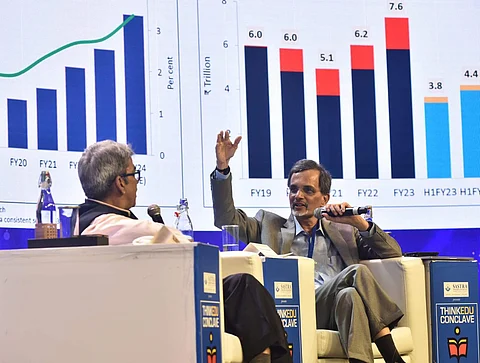

Chief Economic Adviser to the Government of India, V Anantha Nageswaran, allayed concerns regarding the lack of private investments, emphasising an anticipated increase in the gross domestic product (GDP)-investment to 35 percent within the next four years.
Speaking on a panel discussion on “Getting the Economy Right: The Rise of India,” on the second day of the ThinkEdu Conclave 2024, presented by SASTRA University in Chennai, on Thursday, Nageswaran projected a sustained rise in the investment rate, reaching the mid-30s, which, according to him, would result in a seven percent GDP growth. While acknowledging the increased capital expenditure by the government, he suggested a gradual pullback in the rate of growth.
"The momentum of increase witnessed over the last six financial years (FY 2018 - FY 2024) may not necessarily need to be sustained at the same pace. With the private corporate sector actively participating, there is now an opportunity for the government not to retract in absolute terms but to curtail the rate of growth,” said Nageswaran, during the session that was chaired by author and analyst Shankkar Aiyar.
Responding to questions about sustaining public investments, Nageswaran highlighted the government’s increased capital expenditure from 1.8 percent to 3.5 percent of the GDP, partially due to the pandemic.
Addressing the economic recovery, he dismissed notions of a 'K-shaped' recovery, emphasising that rural consumption, although slower than urban consumption, is not contracting.
"Many of these instances are anecdotal; we don't gather statistics based on urban and rural demarcations. In rural India, discretionary consumption spending is on the rise, with rural wages surpassing the inflation rate. I believe that the gap we have observed, or the anecdotal stories about urban consumption versus rural consumption, is likely narrowing,” commented Nageswaran.
Nageswaran underscored the need for improvement in creating jobs in the organized sector and acknowledged the ongoing challenges in terms of formal contracts and regular wage-paying jobs.
“We need to make improvements in terms of the number of people with formal contracts and those having regular wage-paying jobs; these proportions are still relatively smaller. However, it is equally true that the unemployment rate, which peaked at 21% during the pandemic, has now reduced to 6.6 percent in urban India. If we consider the overall unemployment rate, including rural India, it stands at 3.2 percent,” said Nageswaran.
